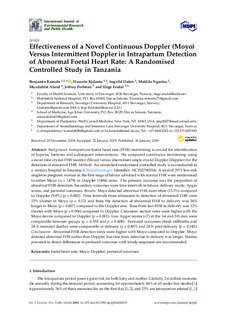| dc.contributor.author | Kamala, Benjamin | |
| dc.contributor.author | Hussein, Kidanto | |
| dc.contributor.author | Dalen, Ingvild | |
| dc.contributor.author | Ngarina, Matilda | |
| dc.contributor.author | Abeid, Muzidalifat | |
| dc.contributor.author | Perlman, Jeffrey | |
| dc.contributor.author | Ersdal, Hege Langli | |
| dc.coverage.spatial | Tanzania | nb_NO |
| dc.date.accessioned | 2019-07-15T08:03:32Z | |
| dc.date.available | 2019-07-15T08:03:32Z | |
| dc.date.created | 2019-05-21T10:39:44Z | |
| dc.date.issued | 2019-01 | |
| dc.identifier.citation | Kamala, B., Kidanto, H., Dalen, I. et al. (2019) Effectiveness of a novel continuous doppler (Moyo) versus intermittent doppler in intrapartum detection of abnormal foetal heart rate: A randomised controlled study in Tanzania. International Journal of Environmental Research and Public Health, 16:315 (3), 1-16. | nb_NO |
| dc.identifier.issn | 1660-4601 | |
| dc.identifier.uri | http://hdl.handle.net/11250/2605399 | |
| dc.description.abstract | Background: Intrapartum foetal heart rate (FHR) monitoring is crucial for identification of hypoxic foetuses and subsequent interventions. We compared continuous monitoring using a novel nine-crystal FHR monitor (Moyo) versus intermittent single crystal Doppler (Doppler) for the detection of abnormal FHR. Methods: An unmasked randomised controlled study was conducted in a tertiary hospital in Tanzania (ClinicalTrials.gov Identifier: NCT02790554). A total of 2973 low-risk singleton pregnant women in the first stage of labour admitted with normal FHR were randomised to either Moyo (n = 1479) or Doppler (1494) arms. The primary outcome was the proportion of abnormal FHR detection. Secondary outcomes were time intervals in labour, delivery mode, Apgar scores, and perinatal outcomes. Results: Moyo detected abnormal FHR more often (13.3%) compared to Doppler (9.8%) (p = 0.002). Time intervals from admission to detection of abnormal FHR were 15% shorter in Moyo (p = 0.12) and from the detection of abnormal FHR to delivery was 36% longer in Moyo (p = 0.007) compared to the Doppler arm. Time from last FHR to delivery was 12% shorter with Moyo (p = 0.006) compared to Doppler. Caesarean section rates were higher with the Moyo device compared to Doppler (p = 0.001). Low Apgar scores (<7) at the 1st and 5th min were comparable between groups (p = 0.555 and p = 0.800). Perinatal outcomes (fresh stillbirths and 24-h neonatal deaths) were comparable at delivery (p = 0.497) and 24-h post-delivery (p = 0.345). Conclusions: Abnormal FHR detection rates were higher with Moyo compared to Doppler. Moyo detected abnormal FHR earlier than Doppler, but time from detection to delivery was longer. Studies powered to detect differences in perinatal outcomes with timely responses are recommended. | nb_NO |
| dc.language.iso | eng | nb_NO |
| dc.publisher | MDPI AG | nb_NO |
| dc.rights | Navngivelse 4.0 Internasjonal | * |
| dc.rights.uri | http://creativecommons.org/licenses/by/4.0/deed.no | * |
| dc.subject | foetal heart rate | nb_NO |
| dc.subject | fostermedisin | nb_NO |
| dc.subject | svangerskap | nb_NO |
| dc.subject | graviditet | nb_NO |
| dc.subject | Moyo | nb_NO |
| dc.subject | Doppler | nb_NO |
| dc.subject | hjertefrekvens | nb_NO |
| dc.title | Effectiveness of a novel continuous doppler (Moyo) versus intermittent doppler in intrapartum detection of abnormal foetal heart rate: A randomised controlled study in Tanzania | nb_NO |
| dc.type | Journal article | nb_NO |
| dc.type | Peer reviewed | nb_NO |
| dc.rights.holder | © 2019 by the authors | nb_NO |
| dc.subject.nsi | VDP::Medical disciplines: 700::Health sciences: 800 | nb_NO |
| dc.source.pagenumber | 1-16 | nb_NO |
| dc.source.volume | 16:315 | nb_NO |
| dc.source.journal | International Journal of Environmental Research and Public Health | nb_NO |
| dc.source.issue | 3 | nb_NO |
| dc.identifier.doi | 10.3390/ijerph16030315 | |
| dc.identifier.cristin | 1699009 | |
| cristin.unitcode | 217,8,6,0 | |
| cristin.unitcode | 217,13,2,0 | |
| cristin.unitname | Institutt for energi- og petroleumsteknologi | |
| cristin.unitname | Avdeling for kvalitet og helseteknologi | |
| cristin.ispublished | true | |
| cristin.qualitycode | 1 | |

